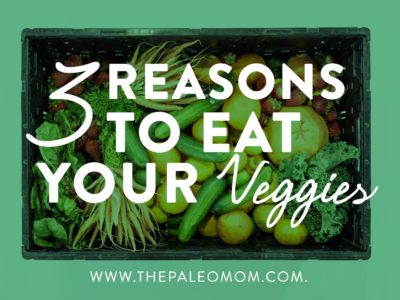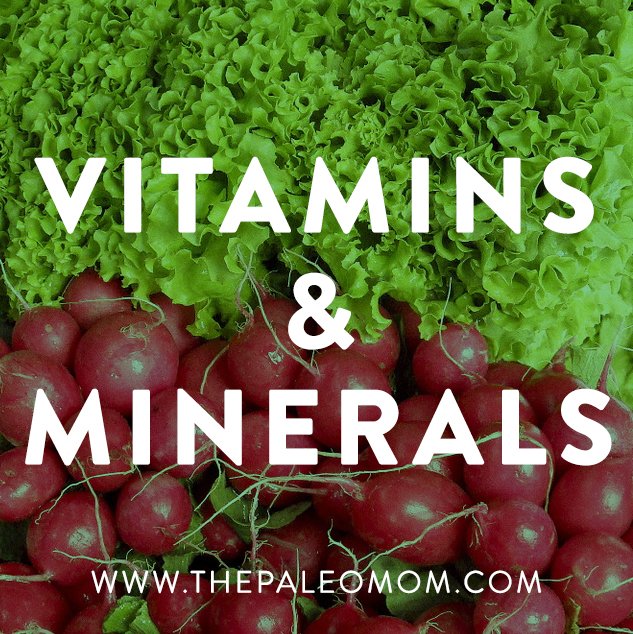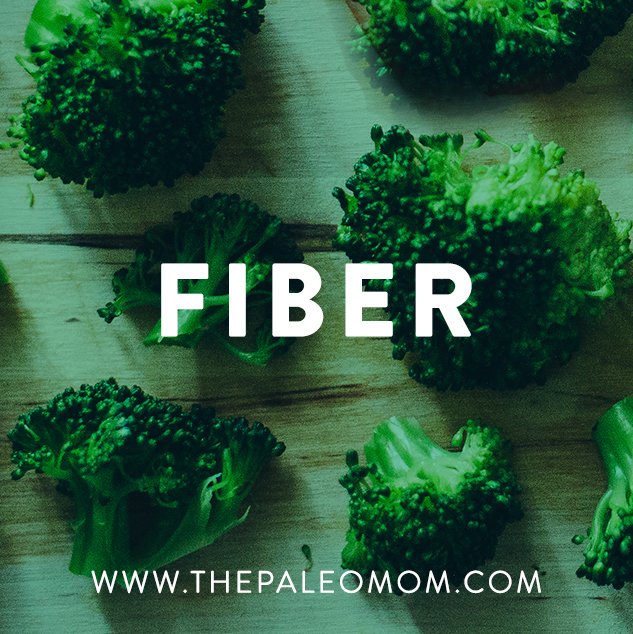One of the foundational principles of my approach to both the Autoimmune Protocol and the standard Paleo diet is a focus on nutrient-dense vegetables. If you’re new to Paleo, you might be surprised to learn that I recommend filling at least ⅔ (ideally ¾) of every plate with a variety of vegetables (including both starchy and non-starchy). The rest of our plates would then be filled out with high-quality proteins and fats.
In fact, the newest research is suggesting that we aim for 8 servings of veggies per day as a bare minimum! For more on the specific ways that high vegetable intake lowers risk of chronic diseases like cardiovascular disease, diabetes, and cancer, see The Importance of Vegetables. There is a wealth of compelling evidence to support a the-more-veggies-the-better approach to eating for health. I’ve written extensively about the principle of nutrient density, which can be simply explained as the idea that optimal foods contain a high number of vitamins, minerals, phytochemicals and other essential nutrients relative to the number of calories they contain (see The Importance of Nutrient Density, Why Are Veggies Crucial on the AIP and The Importance of Vegetables ). And eating a wealth of vegetables is key to a nutrient-dense diet.
In this post, I’m going to address my 3 favorite reasons why we should all eat our veggies!
Vitamins and Minerals
Plants are quite simply the most easily-accessible, affordable and effective sources of many vitamins and minerals we need for optimal health.
Key examples of these vitamins and minerals include vitamin A precursors (carotenoids like lycopene, and beta-carotene), most B vitamins, vitamin C, vitamin K, calcium, chromium, copper, magnesium, manganese, potassium, sulfur and zinc.
Sure, these vitamins and minerals are available in synthetic forms via supplements (and your doctor may recommend targeted treatment that involves one or more of these supplements), but if your goal is overall health, vegetables are a fantastic (and much cheaper!) place to start. First, the vitamins and minerals in plants tend to be more easily absorbed than other sources (supplements or other foods, for example the calcium in kale is more bioavailable than the calcium in milk, see Why Don’t I Need to Worry About Calcium?) and tend to be found in synergistic quantities with other relevant nutrients. Second, plants are often much denser sources of specific essential nutrients than animals (see The Diet We’re Meant to Eat, Part 3: How Much Meat versus Veggies?).
Here, I’ve provided a list of the most common vitamins and minerals and where to find them in plant foods:
B Vitamins: These vitamins are important in cell metabolism (including cell growth and division), immune system function, and nervous system function. Vegetables and fruits rich in B vitamins include: orange and red vegetables (like carrots, sweet potatoes, and beets), grapefruit, peaches, oranges, watermelon, bananas, many green vegetables (like artichoke, asparagus, okra, broccoli, and green pepper), green leafy vegetables, and mushrooms, and cauliflower. Avocado is also very high in several B vitamins. Note: vitamin B12 is not available from plant foods and needs to be consumed from animal foods.
Vitamin C: Vitamin C serves as a potent antioxidant, is necessary for immune system function, and is also necessary for several enzymes to function in the body (like some enzymes that help make collagen, which is why vitamin C deficiency causes scurvy). Vegetables and fruits rich in vitamin C include: oranges, grapefruit, kiwi, berries, papayas, lemons, pineapple, lime, artichoke, asparagus, avocado, broccoli, carrots, cauliflower, cucumber, green pepper, kale, mushrooms, onions, potatoes, spinach, squash, and sweet potato. While some vitamin C is lost with cooking, it’s not as much as you think! See Vegetables: To Cook or Not To Cook
Vitamin K: Vitamin K is critical for making some important proteins in our body that are involved in blood clotting and metabolism. Vitamin K is found in cruciferous vegetables (broccoli, cauliflower, cabbage, kale, Brussels sprouts, turnip greens) and also dark green leafy vegetables. A healthy gut microbiota can convert a substantial amount of the vitamin K1 from veggies into the important bone health versions, vitamin K2.
Calcium: In addition to forming bone, calcium is essential to many processes within the cell, as well as neurotransmitter release and muscle contraction (including our hearts beating!). There’s some research to suggest that the calcium from vegetables is much more readily absorbed and used by our bodies than the calcium in dairy, likely one reason why high vegetable consumption protects against osteoporosis and hip fracture in the elderly. Vegetables and fruit rich in calcium include dark green vegetables, parsnips, papaya, kumquats, black currants, rhubarb, oranges, tangerines, figs, turnips, and butternut squash. Calcium is also found in nuts and seeds, especially sesame seeds. See also Why Don’t I Need to Worry About Calcium?
Nutrivore Weekly Serving Matrix
An easy-to-use and flexible weekly checklist
to help you maximize nutrient-density.
The Weekly Serving Matrix is very helpful! I’ve been eating along these lines but this really helps me know where to focus vs. which foods serve a more secondary role. It’s super helpful and has taken a lot of worry out of my meal planning. Thanks!
Jan
Chromium: Chromium is important for sugar and fat metabolism. Vegetable and fruit sources of chromium include: broccoli, tomatoes, apples, bananas, onions, garlic, cabbage, carrots, mushrooms, parsnips, and green leafy vegetables.
Copper: Copper is involved in the absorption, storage, and metabolism of iron and the formation of red blood cells. Vegetables and fruit containing copper include: artichokes, avocados, pineapple, plums, dates, kiwis, litchis, cherries, parsnips, pumpkin, winter squash, and green leafy vegetables.
Magnesium: Magnesium is necessary for cells to live. Over 300 different enzymes within our cells need magnesium to work, including every enzyme that uses or synthesizes ATP (the basic energy molecule in a cell) and including enzymes that synthesize DNA and RNA. Vegetables and fruit rich in magnesium include all green vegetables, berries, passion fruit, bananas, carrots, squash, sweet potatoes, and especially dark green leafy vegetables like spinach and kale.
Manganese: Manganese is necessary for enzymes that work to protect the body from and repair damage caused by free radicals. Vegetables and fruits high in manganese include sweet potatoes, raspberries, pineapple, grapes, kiwis, figs, bananas, leeks, eggplant, beets, cruciferous vegetables (broccoli, cauliflower, cabbage, kale, Brussels sprouts, turnip greens), and dark green leafy vegetables.
Potassium: Potassium is critical for the function of every cell; it is necessary for nerve function, cardiac function, and muscle contraction. Vegetables and fruit rich in potassium include cruciferous vegetables (broccoli, cauliflower, cabbage, kale, Brussels sprouts, turnip greens), bananas, cantaloupe, avocados, guavas, kiwis, persimmons, apricots, many orange vegetables (carrots, squash, sweet potato), eggplant, and dark green leafy vegetables. See also Is Salt Paleo?
Sulfur: Sulfur is widely used in biochemical processes, including being a component of all proteins and being important for the function of many enzymes and antioxidant molecules. Cruciferous vegetables and vegetables in the onion family are the best sources of sulfur.
Zinc: Zinc is important in nearly every function of the cell, from protein and carbohydrate metabolism to the immune system. Most green vegetables are a good source of zinc, as are pomegranates and avocados.
Phytochemicals
Phytochemicals are chemical compounds found in plants to help them thrive (many thwart off disease and pests). Also, many phytochemicals are responsible for a plant’s color, scent and flavor. Happily, many of these compounds are beneficial to humans and can positively impact our health when regularly consumed. While polyphenols are perhaps the best-known of the phytochemicals, a whole range of important compounds should give us reason to consume more veggies! See The Amazing World of Plant Phytochemicals: Why a diet rich in veggies is so important!
Diallyl Sulfide is a compound created and released by crushing garlic and other alliums (its precursor is allicin). It has potent antimicrobial effects (including acting against the stomach ulcer bacteria H. pylori), reduces risk of cardiovascular disease, and may be responsible for the protective effect that garlic has against colorectal cancer. Foods containing diallyl sulfide include garlic, onions, chives, shallots, scallions, and leeks.
Dithiolethiones are a class of cancer-protective compounds that also induce detoxification. Sources of dithiolethiones include cruciferous vegetables such as broccoli, collard greens, kale, and cabbage.
Polyphenols are a class of chemical compounds with antioxidant properties, helping prevent cell damage from free radicals and potentially reducing the risk of heart disease and other chronic diseases. Rich sources include berries, citrus fruits, brightly colored vegetables, dark chocolate, and plums (see Polyphenols: Magic Bullet or Health Hype?).
Plant Sterols and Stanols have a similar chemical structure to animal cholesterol. These compounds can block the absorption of cholesterol in the small intestine and reduce levels of LDL (“bad”) cholesterol in the blood without altering levels of HDL (“good”) cholesterol. Sources of plant sterols and stanols include nuts, legumes, and most fruits and vegetables.
Flavonoids are a class of more than 6,000 compounds with a range of health benefits, including reducing inflammation, protecting against smoking-related cancers, and reducing cardiovascular disease risk. They also have antibacterial properties. Foods rich in flavonoids include parsley, berries (especially blueberries), citrus fruits, and cocoa.
Isothiocyanates and Indoles are sulfur-containing plant chemicals with strong anticancer properties due to their ability to help suppress tumor formation and eliminate carcinogens from the body. Foods with isothiocyanates and indoles include cruciferous vegetables such as broccoli, cabbage, cauliflower, kale, and Brussels sprouts, especially when eaten raw.
Fiber
Fiber, a carbohydrate present in plant cell walls that our bodies can’t digest, provides us a variety of benefits that almost can’t be overstated. It feeds beneficial probiotic bacteria in our digestive tracts; binds with toxins, hormones, bile salts, cholesterol, and other substances in the gut to facilitate elimination; favorably regulates some hormones (like suppressing the hunger hormone ghrelin, which signals satiety to the brain) and some neurotransmitters (like increasing melatonin, which helps control sleep); and adds bulk to the stool, which improves the quality of bowel movements (see Because Fiber Wasn’t Awesome Enough: New Science Suggests Fiber Improves Sleep Quality, 5 Reasons to Eat More Fiber, and How many carbs should you eat?).
Woot! That was quite a bit! If you’ve read my exhaustive series on fiber (start with The Fiber Manifesto, Pt. 1 of 5: What is Fiber and Why is it Good?), you know I take this subject quite seriously. One reason is that beyond the immediate benefits of fiber, there’s tons of research to support the idea that fiber actually reduces our disease risk. The higher your fiber intake, the lower your inflammation. Hunter-gatherers consume between 45 grams and about 200 grams daily, so there’s an ambitious target for you! (USDA guidelines suggest a minimum of 25 grams daily for women and 38 grams daily for men.)
Diets rich in fiber reduce the risk of cardiovascular disease and of many cancers (especially colorectal cancer, but also liver cancer, pancreatic cancer, and others), and promote overall lower inflammation. High-fiber diets reduce the risk of mortality in cases of kidney disease and diabetes, and can even reduce your risk of dying from an infection! And a diet rich in fiber from vegetables and fruit can cause monumental positive changes in the types of bacteria growing in your gut in as little as three to four days!
Fiber is broadly categorized as soluble or insoluble (that is, whether or not it dissolves in water), and both classes of fiber have different health benefits. In general, foods that are high in fiber include fruit (especially berries), vegetables (especially leafy green vegetables, root vegetables, and cruciferous vegetables), legumes, and nuts and seeds. Rich sources of soluble fiber include apples, berries, pears, citrus fruits, and legumes. Foods high in insoluble fiber include leafy green vegetables, bell peppers, cruciferous vegetables (such as broccoli, bok choy, cauliflower, and Brussels sprouts), artichoke, asparagus, celery, and carrots.
So there you have it! Three scientifically-backed excuses to load 2/3 to 3/4 of your plate with veggies. Enjoy!














